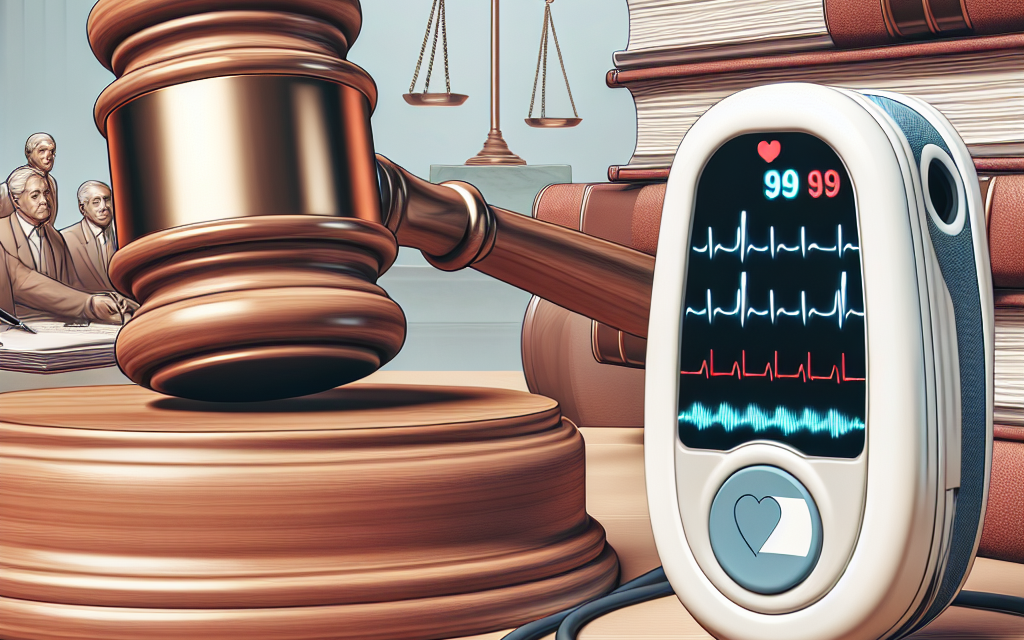Medtronic Exits Pulse Oximeter Lawsuit as FDA Continues Guidance Development

The medical device industry is no stranger to legal challenges and regulatory scrutiny. Recently, Medtronic, a global leader in medical technology, made headlines by exiting a lawsuit concerning its pulse oximeters. This development comes at a time when the U.S. Food and Drug Administration (FDA) is actively working on refining its guidance for these critical devices. This article delves into the intricacies of the lawsuit, the role of pulse oximeters in healthcare, the FDA’s ongoing efforts to enhance device guidance, and the broader implications for the medical device industry.
The Medtronic Pulse Oximeter Lawsuit: An Overview
Medtronic’s involvement in the pulse oximeter lawsuit has been a focal point for both the company and the medical device industry. Understanding the background and details of this legal case is crucial to grasp its significance.
Background of the Lawsuit
The lawsuit against Medtronic centered around allegations that its pulse oximeters were not providing accurate readings under certain conditions. Pulse oximeters are devices used to measure the oxygen saturation level in a patient’s blood, a critical parameter in various medical settings. The accuracy of these devices is paramount, as incorrect readings can lead to misdiagnosis or inappropriate treatment.
The plaintiffs in the lawsuit claimed that Medtronic’s devices failed to deliver reliable results, particularly in patients with darker skin tones. This allegation is part of a broader concern within the medical community about the potential for racial bias in medical devices, which can have serious implications for patient care.
Medtronic’s Response and Legal Strategy
Medtronic, known for its robust legal and regulatory teams, approached the lawsuit with a comprehensive strategy. The company maintained that its pulse oximeters met all regulatory standards and were designed to provide accurate readings across diverse patient populations.
In its defense, Medtronic highlighted its commitment to continuous improvement and innovation in medical technology. The company emphasized its ongoing efforts to enhance the performance of its devices through rigorous testing and validation processes.
Resolution and Exit from the Lawsuit
After months of legal proceedings, Medtronic reached a settlement agreement with the plaintiffs, allowing the company to exit the lawsuit. While the terms of the settlement were not publicly disclosed, Medtronic’s decision to settle was likely influenced by a desire to avoid prolonged litigation and focus on its core business operations.
The resolution of the lawsuit underscores the importance of addressing potential biases in medical devices and highlights the need for ongoing collaboration between manufacturers, regulators, and healthcare providers to ensure patient safety and equitable care.
Implications for the Medical Device Industry
The Medtronic lawsuit serves as a cautionary tale for the medical device industry, emphasizing the need for rigorous testing and validation of devices across diverse patient populations. It also highlights the growing scrutiny of potential racial biases in medical technology, a concern that is gaining traction among regulators and healthcare professionals.
As the industry continues to innovate and develop new technologies, manufacturers must prioritize inclusivity and accuracy in their devices to meet the evolving needs of patients and healthcare providers.
Lessons Learned and Future Directions
The resolution of the Medtronic lawsuit offers valuable lessons for the medical device industry. Companies must proactively address potential biases in their devices and engage in transparent communication with regulators and stakeholders.
Looking ahead, the industry must continue to invest in research and development to enhance the accuracy and reliability of medical devices. Collaboration with regulatory bodies, such as the FDA, will be crucial in shaping the future of medical technology and ensuring that devices meet the highest standards of safety and efficacy.
The Role of Pulse Oximeters in Healthcare
Pulse oximeters play a vital role in modern healthcare, providing critical information about a patient’s oxygen saturation levels. Understanding their function and significance is essential to appreciate the impact of the Medtronic lawsuit and the FDA’s guidance development efforts.
Functionality and Importance of Pulse Oximeters
Pulse oximeters are non-invasive devices that measure the oxygen saturation level in a patient’s blood. They work by emitting light through a patient’s skin and measuring the amount of light absorbed by oxygenated and deoxygenated hemoglobin. The device then calculates the percentage of oxygen saturation, providing healthcare providers with valuable information about a patient’s respiratory status.
These devices are widely used in various medical settings, including hospitals, clinics, and home care. They are particularly important in monitoring patients with respiratory conditions, such as chronic obstructive pulmonary disease (COPD), asthma, and COVID-19.
Applications in Clinical Practice
Pulse oximeters are essential tools in clinical practice, aiding in the diagnosis and management of respiratory conditions. They are used to:
- Monitor oxygen levels in patients with respiratory diseases
- Assess the effectiveness of oxygen therapy
- Detect hypoxemia (low blood oxygen levels) in critically ill patients
- Guide treatment decisions in emergency and critical care settings
The widespread use of pulse oximeters underscores their importance in ensuring patient safety and optimizing clinical outcomes.
Challenges and Limitations
Despite their widespread use, pulse oximeters have limitations that can impact their accuracy. Factors such as poor circulation, skin pigmentation, and ambient light can affect the device’s readings. These limitations have raised concerns about the potential for racial bias, as studies have shown that pulse oximeters may provide less accurate readings in individuals with darker skin tones.
Addressing these challenges is crucial to ensuring that pulse oximeters provide reliable and equitable care for all patients. Manufacturers must prioritize research and development to enhance the accuracy and inclusivity of these devices.
Technological Advancements and Innovations
The medical device industry is continuously innovating to improve the performance of pulse oximeters. Recent advancements include the development of multi-wavelength devices that can provide more accurate readings across diverse patient populations. Additionally, wearable pulse oximeters and smartphone-integrated devices are gaining popularity, offering convenient and accessible monitoring options for patients.
These technological advancements hold promise for enhancing the accuracy and reliability of pulse oximeters, ultimately improving patient care and outcomes.
The Future of Pulse Oximetry in Healthcare
As the healthcare landscape continues to evolve, pulse oximeters will remain a critical tool in patient monitoring and management. The ongoing development of more accurate and inclusive devices will be essential to meeting the diverse needs of patients and healthcare providers.
Collaboration between manufacturers, regulators, and healthcare professionals will be key to driving innovation and ensuring that pulse oximeters continue to play a vital role in modern healthcare.
FDA’s Role in Guiding Pulse Oximeter Development
The FDA plays a crucial role in regulating medical devices, including pulse oximeters. The agency’s efforts to develop guidance for these devices are essential to ensuring their safety and efficacy.
Regulatory Framework for Medical Devices
The FDA is responsible for overseeing the safety and effectiveness of medical devices in the United States. The agency’s regulatory framework includes premarket approval, post-market surveillance, and guidance development to ensure that devices meet the highest standards of safety and efficacy.
For pulse oximeters, the FDA’s guidance focuses on performance standards, testing requirements, and labeling considerations to ensure that these devices provide accurate and reliable readings across diverse patient populations.
Challenges in Regulating Pulse Oximeters
Regulating pulse oximeters presents unique challenges due to the potential for racial bias and the limitations of current technology. The FDA must balance the need for rigorous testing and validation with the desire to promote innovation and accessibility in the medical device industry.
Addressing these challenges requires collaboration between the FDA, manufacturers, and healthcare professionals to develop guidance that ensures the safety and efficacy of pulse oximeters while promoting inclusivity and equity in patient care.
Ongoing Efforts to Enhance Guidance
The FDA is actively working to enhance its guidance for pulse oximeters, focusing on addressing potential biases and improving device performance. The agency is engaging with stakeholders, including manufacturers, healthcare providers, and patient advocacy groups, to gather input and develop comprehensive guidance that reflects the needs of diverse patient populations.
These efforts are part of a broader initiative by the FDA to promote health equity and ensure that medical devices provide accurate and reliable care for all patients.
Impact of FDA Guidance on the Medical Device Industry
The FDA’s guidance for pulse oximeters has significant implications for the medical device industry. Manufacturers must adhere to the agency’s standards and requirements to ensure that their devices meet regulatory expectations and provide safe and effective care.
The development of comprehensive guidance also presents opportunities for innovation, as manufacturers are encouraged to develop new technologies and approaches to enhance the accuracy and inclusivity of pulse oximeters.
The Future of FDA Guidance for Pulse Oximeters
As the FDA continues to refine its guidance for pulse oximeters, the agency’s efforts will play a critical role in shaping the future of these devices. The development of comprehensive and inclusive guidance will be essential to ensuring that pulse oximeters provide accurate and reliable care for all patients.
Collaboration between the FDA, manufacturers, and healthcare professionals will be key to driving innovation and ensuring that pulse oximeters continue to play a vital role in modern healthcare.
Implications for the Medical Device Industry
The Medtronic lawsuit and the FDA’s guidance development efforts have significant implications for the medical device industry. Understanding these implications is crucial for manufacturers, regulators, and healthcare providers.
Addressing Racial Bias in Medical Devices
The Medtronic lawsuit highlights the need for the medical device industry to address potential racial biases in its products. Manufacturers must prioritize research and development to ensure that their devices provide accurate and reliable care for all patients, regardless of skin tone or other demographic factors.
Addressing racial bias in medical devices is essential to promoting health equity and ensuring that all patients receive safe and effective care.
Opportunities for Innovation and Improvement
The challenges highlighted by the Medtronic lawsuit and the FDA’s guidance development efforts present opportunities for innovation and improvement in the medical device industry. Manufacturers are encouraged to develop new technologies and approaches to enhance the accuracy and inclusivity of their devices.
These opportunities for innovation hold promise for improving patient care and outcomes, ultimately benefiting the healthcare system as a whole.
Collaboration and Stakeholder Engagement
Collaboration between manufacturers, regulators, and healthcare providers is essential to addressing the challenges facing the medical device industry. Engaging with stakeholders and gathering input from diverse perspectives will be crucial to developing comprehensive guidance and ensuring that devices meet the needs of all patients.
Stakeholder engagement will also be key to driving innovation and promoting health equity in the medical device industry.
Regulatory Compliance and Market Access
Adhering to regulatory standards and requirements is essential for manufacturers seeking to bring their devices to market. The FDA’s guidance for pulse oximeters will play a critical role in shaping the regulatory landscape and ensuring that devices meet the highest standards of safety and efficacy.
Manufacturers must prioritize regulatory compliance to ensure market access and provide safe and effective care for patients.
The Future of the Medical Device Industry
The Medtronic lawsuit and the FDA’s guidance development efforts are shaping the future of the medical device industry. As manufacturers continue to innovate and develop new technologies, they must prioritize inclusivity, accuracy, and regulatory compliance to meet the evolving needs of patients and healthcare providers.
The future of the medical device industry will be defined by collaboration, innovation, and a commitment to health equity, ultimately benefiting patients and the healthcare system as a whole.
Conclusion
The Medtronic pulse oximeter lawsuit and the FDA’s ongoing guidance development efforts highlight the challenges and opportunities facing the medical device industry. As manufacturers, regulators, and healthcare providers work together to address potential biases and enhance device performance, the industry is poised for innovation and improvement.
Collaboration and stakeholder engagement will be key to driving progress and ensuring that medical devices provide accurate and reliable care for all patients. By prioritizing inclusivity, accuracy, and regulatory compliance, the medical device industry can continue to play a vital role in modern healthcare, ultimately benefiting patients and the healthcare system as a whole.





